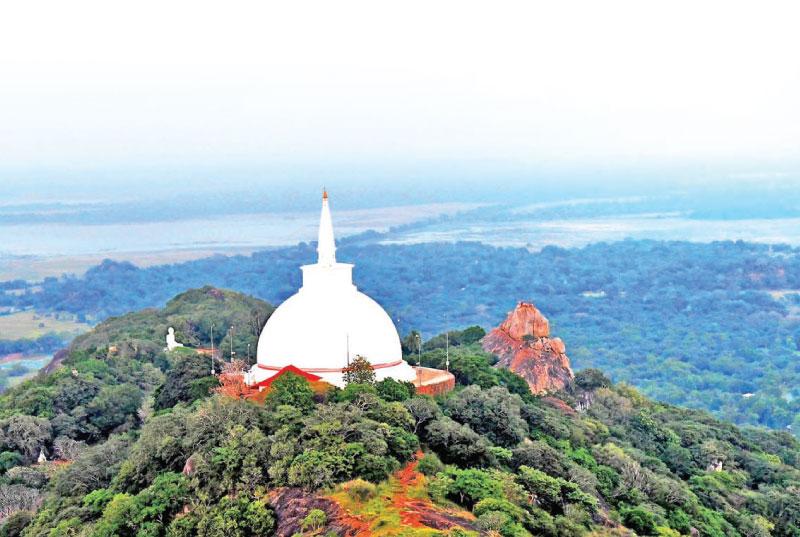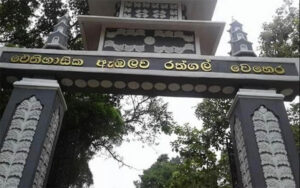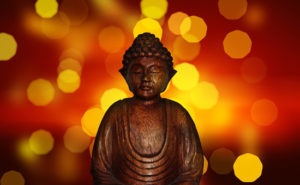
Sagiriya is the sacred place where the first seed of Sinhala Buddhist culture was sown. It has been anointed in the history tradition as the Sinhalese national heritage. According to anecdotal evidence, Hela Buddhists are regarded as an ancestor of Buddhists.
It is said that in the Poson Poya days, Lord Mahinda had been living in a beautiful mixed rock with four Ittiyas, Uthtiya, Sambalas, Baddasalas, Sumanas and Prince Bhanduka. King Pathis II, who went to the Mixed Pavilion, to the god of the rock, the king, to the sacred Buddha, Ægena and also that he did to (Mahavamsa, Chapter 14, 2-6 stanzas) Mahavamsa said.
According to the Mahavamsa, the historical meeting took place after the abandonment of literary lore and the archeological evidence at Mihinthale shows that this place was the center of the sacred land of the Buddha Sasana.
From the moment this historic encounter took place, Sagiriya was a pilgrimage site with special patronage.
The Mihindu Thero preached the Chulla Hatti Padopama Sutta in Sri Lanka as the first sermon on Sri Lanka. It is in this land that King Buddhists, including King Second Path, embraced Buddhism. (Mahavansa, Chapter 13, pp. 22-23). The first night in Sri Lanka was spent in the cave known as the Mihindu Cave. (Mahavamsa, Chapter 20, pp. 16-17).
The first person to enter a monk’s land in Sri Lanka is a mixed race. It was Prince Bhanduka who came with the Thera. It was in this village that he became ordained and ordained as a Rහත්dha
(Mahavamsa, chapter 14, stanza 26 and stanza 31-33). The Buddhist monks, including thera, spent their first years in a mixed family. (Mahavansa, Chapter 16, pp. 8-9). Beginning with the generation of Sinhala bhikkhu, he and his 52 younger brothers are buried in a mixed family. (Mahavansa, Chapter 16, pp. 10-11).
King Pathis II made 68 caves in the Sangha and made the first cave sacrifice in a mixed family. That is, the first historical Buddhist monastery originated in Mihintale (Mahavamsa, chapter 16, strata). In Thumburumalaka, a group of monks who ordinarily restrict themselves to the constellations of Dattis, are ordained in the mixed race. This is how the great culture of Sinhalese has been planted on this land and it is a place of pilgrimage.
During the second hour of the reign of King Pissawa of Missaka, it was named Giri Giri.
The first sacred relics of Sri Lanka are placed in the Mixed Rock for the first time in Sri Lanka. The Mahavamsa says that from that time on, the Mixed Rock was the Chaitya Rock or Sagiriya. (Mahavansa, chapter 17, stanza 23). The sacred ground, which forms one of the most obscure Bo-trees, is Sagiri Arama. (Mahavamsa, chapter 19, stanza 62). Arahant Mahinda Thero spent his last years in the sacred area. (Mahavamsa, Chapter 22, pp. 32-34). It is in Sagiri Vehera that the King Uththaya is made a stupa to treasure his relics. (Chapter 20 of Mahavansa, pp. 46-47).
It is because of this historical reality that Sagiriya is worshiped by the Buddhists. Even an invader, the pagan King Elara, went to Sagiriya to observe the ritual and meet the Bhikkhu Sangha. (Mahavansa, Chapter 21, pp. 21-22). It is evident that the villages such as Dooramalawa, near Sira Giri during the Elara king’s day were a prosperous city in the foreign trade. (Mahavamsa Chapter 23, stanza 24).
King Lajjitissa, who was disillusioned with the Sangha due to the sangha’s initiation into the throne, was the chief occupation of the Buddhist monk. The Mahavansa states that Makalanthis made a great pooja in the kingdom of Sagiriya and joined the Sela Chaitya in front of it. (Mahavansa, chapter 34, stanza 31).
During the reign of Bhatikabhaya there were about a thousand bhikkhus in Chetiyagiri. The king had offered him a regular ration. (Mahavamsa, chap. 34, pp. 63-64). King Mahadhanika, the great Mahadanaka, performed the great Mahasaka. The chronicler of the Ambatala sa industry:
When the stupa was built, the part with the foundation collapsed. The king is there to meditate on the Buddha. With the sacrifice of his soul, he stopped the collapse of the land. Then came the Seya. He set up four doorways of gold and gold. They were made of gemstones and set with gold bubbles and hanging pearls. (Mahavamsa, chapter 35, stanzas 70-74).






